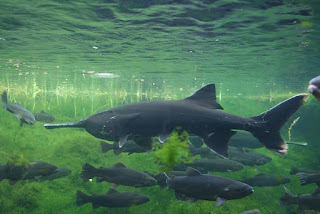Paddlefish Unchanged over Alleged Millions of Years
At first glance, the American paddlefish can be mistaken for a shark. Scientists long ago thought this was the case, but paddlefish and sharks are not close relatives. Its appearance is rather startling. There are or were relatives of Polyodon spathula in China and the Mississippi River.
 |
| Paddlefish Polyodon spathula, WikiComm / Хомелка (CC BY-SA 3.0) |
"Isn't that a 1984 song by Madonna, Cowboy Bob?"
"No, that's 'Like a Sturgeon.'"
How did you guys get in here? You're both wrong, anyway.
Speaking of sturgeon, the paddlefish is related to them. In fact, they startled believers in fish-to-fool evolution when it was discovered that the two fish could interbreed.
Because these fish have remained unchanged for millions of Darwin years, they are living fossils. Evolutionists call it stasis (they didn't evolve because they didn't need to), which is a way to get out of the problem this presents. Anyone with some thinking abilities and a bit of science knowledge should see that all living things in vast amounts of time should have changed through "evolutionary pressures." After all, some researchers suspect that humans are influencing the evolution of the Great Tit in Britain, and that was in a short amount of time.
We considered how some fish have electric organs, and the paddlefish has some electrical capabilities as well. No, it won't give anything a jolt, but it uses its ability to its show — plankton. They are filter feeders, which is essentially open wide, swim, and filter what they want. Not only does the paddlefish defy evolution by being a living fossil, it also demonstrates that it was designed by the Creator.
Evolutionists consider the freshwater paddlefish (Polyodon spathula) of the class Actinopterygii to be a prehistoric creature, a primitive bony fish “50 million years” older than the dinosaurs—making the freshwater paddlefish “350 million years” old.
. . .
This alleged “prehistoric” creature is impressively designed with special cellular sensors called electroreceptors. These hair cells are contained in a structure called the ampullary organ located on the extension or beak-like process of the paddlefish’s snout (rostrum).
. . .
The paddlefish has made the news recently because decades ago its habitat in Texas (they are also found in the Mississippi River basin and China) was disrupted by a dam that was built upstream. The waterflow needed for the fish to survive was altered, causing the fish to die out [in Texas] in the 1970s.
To read the entire article, visit "'Prehistoric' Paddlefish?"